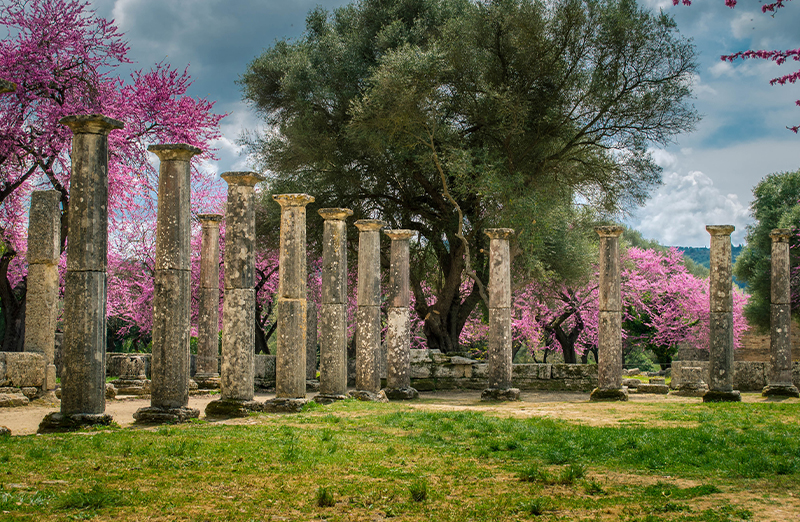The land that was host to the ancient Olympiads, the games that were held to honor the Olympian Gods, the chief festivities in ancient Greece, Ancient Olympia is home to one of the world’s most important archaeological sites.
It’s at least a 3.5-hour drive from Athens to Olympia, the home of the original Olympic Games. Thousands of visitors that arrive here from across the globe are able to uncover the true essence of the Games, whose goal and purpose was to bring out the best in each competitor. Let a professional driver do the hard work while you sit back and enjoy the onboard Wi-Fi on this private tour: all drivers are native speakers of English and know Greek history well. Spend around half a day exploring the site in depth (entrance fees not included) before returning to Athens.
At the heart of the site and within the magnificent temple dedicated to Zeus, was the famed gold and ivory statue of the god, a work of the sculptor Phidias and one of the seven wonders of the ancient world. From the 9th century BC, Olympia was a sacred place that attracted worshipers from around the ancient world. Starting from the 8th century BC, the celebrations at Olympia became associated with the Sacred Olympic Truce, honored throughout the Greek world. In the 5th century BC, Olympia became a place where ideas were spread, with dozens of thinkers coming here to exchange ideas.
- Spend the day at ancient Olympia, a UNESCO World Heritage Site
- Explore the ruins plus all three of the on-site museums independently
- Onboard Wi-Fi keeps you connected without the roaming charges
- Private transfers direct from your door save time—important over a long day





- Professional drivers with deep knowledge of history (not licensed to accompany you in any site)
- Hotel/ airport/ port pick-up and drop-off
- Private transportation
- Air-conditioned vehicle
- WiFi on board
- Bottled water
- Lunch (With Greek Traditional Food option)
- Licensed tour guide
- Entry or admission fees for archaeological sites
- Gratuities
- Our drivers are not official tour guides, but they are knowledgeable and can provide fascinating commentary in fluent English. Although they will not enter the archaeological sites with you, they can answer most of your questions about the places you visit with this tour.
- Our company complies with all the health instructions of the World Health Organization about COVID-19
- Third party activities and especially extreme sports are not allowed during the tour. This could be a cause for immediate cancellation of the tour.
- This is a private tour. Only your group will participate. The pick-up time is adjustable upon your request. Your personal driver will pick you up and return you to the same place or to the point you prefer.
- In the case of a hotel pick-up, he will be waiting for you in the hotel lobby.
- In the case of an apartment pick-up, he will be waiting for you at the entrance of the building.
- For airport pick up, he will be waiting for you at the arrival hall holding a sign with your name on it so you can spot him upon arrival. We will track your flight and our driver will be there on time.
- For port pick up, he will be waiting for you at the gate, just as you disembark, holding a sign with your name on it so you can spot him upon arrival.
- Comfortable clothing
- Athletic/ walking shoes are recommended
- Hats, sunglasses, and suntan lotion are highly recommended
- You can cancel up to 24 hours in advance of the experience for a full refund.
- If you cancel less than 24 hours before the experience’s start time, the amount you paid will not be refunded.
-
Any changes made less than 24 hours before the experience’s start time will not be accepted.
Tour itinerary
12 hours roundtrip | 2 places | 1 stop for lunch
Start our tour from Athens
We start our tour early in the morning from Athens. Our driver will pick you up from your hotel/ apartment or the airport/ port.
Corinth Canal
The Corinth Canal connects the Gulf of Corinth in the Ionian Sea with the Saronic Gulf in the Aegean Sea. It cuts through the narrow Isthmus of Corinth and separates the Peloponnese from the Greek mainland, arguably making the peninsula an island. The canal was dug through the isthmus at sea level and has no locks. It is 6.4 kilometres (4 mi) in length and only 21.4 metres (70 ft) wide at its base, making it impassable for many modern ships.
From high up, you can enjoy the best view of Corinth's isthmus and admire the steep limestone walls while you observe the vessels below you navigate their way through the canal.
Olympia
Arrival at Ancient Corinth after a 3.5-hour trip.
Olympia was a sacred place that attracted worshipers from around the ancient world. Starting from the 8th century BC, the religious celebrations at Olympia became associated with the Sacred Olympic Truce, honored throughout the Greek world following an agreement between the Spartan Lykourgos and the King of Elis, Iphitos. In the 5th century BC, Olympia became a place where ideas were spread, with dozens of thinkers and influential individuals coming here to exchange and pass on their knowledge and ideas.
Archaeological site of Olympia
The archaeological site held over 70 significant buildings, and ruins of many of these survive. Of special interest to Greeks of all times is the Pelopion, the tomb of the quasi-mythical king, ancestor of the Atreids, the two kings who led their domains to war against Troy. The Peloponnesus is named for Pelops. The tomb suggests that he may not have been entirely mythical.
Temple of Zeus
The Temple of Zeus at Olympia was an ancient Greek temple in Olympia, Greece, dedicated to the god Zeus. The temple, built in the second quarter of the fifth century BC, was the very model of the fully developed classical Greek temple of the Doric order.
Stadium at Olympia
The stadium at the archaeological site of Olympia, Greece, is located to the east of the sanctuary of Zeus. It was the location of many of the sporting events at the Ancient Olympic Games.
Temple of Hera
The Temple of Hera, or Heraion, is an ancient Archaic Greek temple that was dedicated to Hera, queen of the Greek gods. It was the oldest temple at Olympia and one of the most venerable in all Greece. It was originally a joint temple of Hera and Zeus, chief of the gods, until a separate temple was built for him. It is at the altar of this temple, which is oriented east-west, that the Olympic flame is lit and carried to all parts of the world. The torch of the Olympic flame is lit in its ruins to this day. The temple was built in approximately 590 BC, but was destroyed by an earthquake in the early 4th century CE.
Nymphaeum
Nymphaeum, “home of the Nymphs” or water goddesses was the official name of a water-distribution structure constructed in the mid-2nd century at that site to provide water to the masses who attended the Olympic Games in July and August. Nymphaeum was the general name throughout the Mediterranean for an ornate structure that terminated an aqueduct bringing water from distant elevated terrain, say a stream or copious springs. This one had substructures, statues, and ornately patterned stonework; its main purpose, however, was functional. It received water from the aqueduct into a cistern and released it by stages into a system of open and closed channels leading around the site. The end partaker of the water carried a secular patera, or small drinking bowl, around with him, dipping into an open trough for the water, as is suggested by the fact that at least some of the statues carried such paterae in one hand. Troughs went everywhere through the site to accommodate the crowds.
Palaestra
The palaestra is the ground or grounds in ancient Olympia where “pali” (“wrestling”) was taught and performed for training purposes, i.e. “wrestling-school”. Two other martial arts were taught there: Greek πυγμή (pygme), Latin pugnus, "fist, boxing," and Greek παγκράτιον, Latin pancration or pancratium, "any method," which was free-style, or hand-to-hand, including grappling, kicking, punching, or any unarmed method whatever, no holds barred. The latter was sometimes deadly, or disfiguring (with permission), which indicates that the arts were ephebic, or "soldier" training for prospective citizens of the city-state sponsoring the school, such as Elis, but here combined with prospective candidacy for contention in the games. Be that as it may, none of the games were conducted without rules, umpires, and judges, who did not hesitate to stop contests, fine contenders within some cases amounts prohibiting future participation, or bar flagrant violators.
Philippeion
The Philippeion in the Altis of Olympia was an Ionic circular memorial in limestone and marble, a tholos, which contained chryselephantine (ivory and gold) statues of Philip's family: himself, Alexander the Great, Olympias, Amyntas III and Eurydice I. It was made by the Athenian sculptor Leochares in celebration of Philip's victory at the battle of Chaeronea (338 BC). It was the only structure inside the Altis dedicated to a human.
The temple consisted of an outer colonnade of Ionic order with 18 columns. Inside it had nine engaged columns of the lavishly designed Corinthian order. It had a diameter of 15 meters. The naos contained two windows, much like Hera II at Paestum. It had a carved marble roof which was decorated with a bronze poppy head on top.
Archaeological Museum of Olympia
The Archaeological Museum of Olympia is one of the principal museums of Greece, located in Olympia. It is overseen by the Ministry of Culture and Sports, and, as of 2009, is directed by Georgia Chatzi. When the original building was completed and opened in 1882, it was the first museum in Greece outside of Athens.
The museum houses discoveries from the surrounding area, including the site of the Ancient Olympic Games. The collection includes objects produced and used in the area from prehistory to its time under Roman rule. The principal pieces in the museum are Hermes and the Infant Dionysus (attributed to Praxiteles), some objects from the Temple of Zeus, the Nike of Paionios, as well as an oenochoe that belonged to Phidias. The extent of its bronze collection makes it one of the most important in the world.
Museum of Olympic Games
The ancient Olympic Games were a series of athletic competitions among representatives of city-states and one of the Panhellenic Games of Ancient Greece. They were held in honor of Zeus, and the Greeks gave them a mythological origin. The first Olympic Games are traditionally dated to 776 BC. The games were held every four years, or Olympiad, which became a unit of time in historical chronologies. They continued to be celebrated when Greece came under Roman rule, 2nd century BC. Their last recorded celebration was in AD 393, under the emperor Theodosius I, but archeological evidence indicates that some games were still held after this date. The games likely came to an end under Theodosius II, possibly in connection with a fire that burned down the temple of the Olympian Zeus during his reign.
Map Overview
Available Pickups
NOTE: Pick-up starts 10 minute(s) before departure.
We offer pick-up to the following places for this experience:
Tour info
Experience type
Day tour / activity
Difficulty
Easy
Booking in advance
Cut off: 1 day
Live tour guide
English
Awards & Certifications




Trip Advisor Reviews
News, offers & beyond
Type in your e-mail to receive our latest news, new tours & transfer options and special tour offers and personalised discounts!
This site is protected by reCAPTCHA and the Google Privacy Policy and Terms of Service apply.














